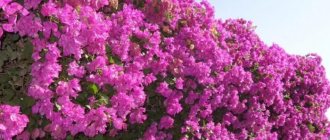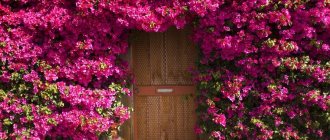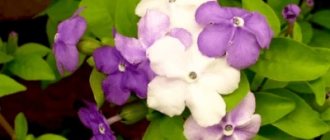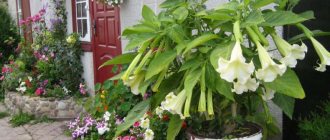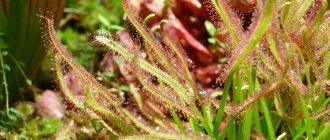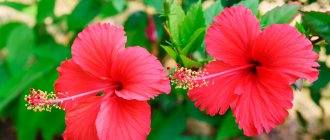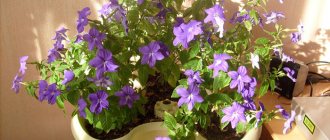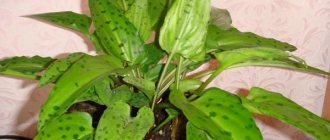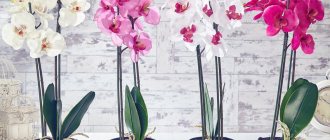Garden bougainvillea is a shrub with a branched stem and climbing shoots. The plant is quite rare in gardens, which is associated with some growing difficulties.
Valued for its abundant flowering, beautiful and bright bracts, which come in purple, lilac, white, orange and various shapes. Bougainvillea is wonderful and smooth in cultivation. The liana reaches a height of more than 10 meters. Indoor bougainvillea is compact in size; the plant is grown in pots in regions with cold climates. Garden bougainvillea reaches its peak decorative value 4-5 years after planting.
Bougainvillea
Bougainvillea is an unusually beautiful shrub native to Brazil. It is a favorite decoration for apartments and greenhouses. Beginning flower growers are interested in everything about the bougainvillea plant, care at home, features of cultivation and all existing varieties and species.
Most experienced flower growers claim that bougainvillea is the most luxurious and beautiful plant. If this judgment is very widespread, then it’s time to get to know this exotic beauty better and learn more about the representative originally from Brazil.
Description of the plant
This exotic beauty is difficult to confuse with other representatives. It is distinguished by its unusually lush appearance and beautiful bracts, which are often mistaken for the main flowers.
The leaves are oval in shape, with a pointed end. Their color is bright green, and on the reverse side, the leaf is much lighter. The main flowers are small in size and pale yellow in color.
Know. These shrubs have become famous for their bracts, which are found in the shape of hearts, triangles, and sometimes round.
Due to the unusual bracts, bougainvillea received the name paper flower, since they look as if they were created from crumpled paper. Bracts decorate the bush for a very long time. As for primary colors, they fade and fade quickly.
It is also important that the exotic beauty, growing at home, blooms from May to November. Having once seen this gorgeous bush, every gardener admits that bougainvillea has won his heart forever.
Species diversity
It does not differ in an extensive list:
- Naked bougainvillea (Bougainvillea glabra). This plant is five meters high and has bracts of various colors. They can be white, yellow, purple, pink or red. The spines of this variety are not large in size. Naked bougainvillea is easy to shape because pruning is not a problem for it. 1850 was the period when Jacques Denis Choise, a Swiss botanist, described Bougainvillea glabra. The plant can be found in dry areas of Brazil. It usually likes rocky hills if they have carbonate soil.
- Wonderful bougainvillea (Bougainvillea spectabilis). Fifteen meters in height are impressive indicators for a plant. Pink, red and purple bracts are large. With these parameters, something like a vine can wrap around the facades and walls of gazebos due to the flexibility of the shoots and a large number of thorns. The plant blooms from April to December. The homeland of the Wonderful (Beautiful) bougainvillea is the Brazilian tropical forests.
- Peruvian bougainvillea (Bougainvillea peruviana).
Humboldt, a naturalist from Germany, discovered this variety for gardeners in 1810. The climbing plant has yellow flowers framed by purple and pink round bracts. Peruvian bougainvillea has short thorns and thin, ovate leaves. Lateral shoots do not appear in this variety, so the variety is considered stable in terms of plant pruning. Colombia and Peru are home to Bougainvillea peruviana. Three species were subsequently cultivated, and breeders developed the following varieties: - Australian Gold. A shrub with double bracts changes over time. Their original color changes from bright orange to pink. On large oval sheets, in some cases, burgundy spots appear.
- California Gold. The plant is interesting because it often confuses the flowering time and “transfers” it to the winter. It has golden bracts at the ends, which is why it got its name. Over time, this golden patina disappears and turns into a beige shade.
- Double Lilarose. Flame-like bracts are the main characteristic of this spectacular variety. They will delight the eye of a lover of all things beautiful for a long time, if you don’t overdo it with watering.
- Double Red. This variety is valuable because its purple-crimson color does not lose its brightness throughout the entire flowering period.
- White Cascade. The bracts of this variety are beautiful and resemble ivory in tone. Some of them may have a pink border.
- Beggum Sikkander. We are talking about an indoor plant with light green leaves. The bracts have a double color. The most popular combination is a white core and a purple frame.
Origin
This bush comes from Brazil. In its area of residence, it is found as a small tree or vine. But the most common specimens are in the form of a bush with shoots covered with thorns.
The shoots of the plant grow quickly and are up to 5 meters long. In our climate zone, it can be kept in a house or in a greenhouse. Although there are people who plant a bush outside in the warm season, and before winter they hide it indoors.
The bougainvillea flower is quite famous; it has earned its popularity thanks to its long flowering. In its homeland, the shrub blooms all year round. It grows on rocky slopes and bathes in sunlight. Growing an exotic beauty at home is not difficult if you know what kind of care and soil it needs.
Once upon a time, a French writer, lawyer and traveler discovered and gave the world the most beautiful bougainvillea flower. In his declining years, he said with sadness that the world would recognize his surname thanks to a flower. And so it turned out, not many people know the great traveler, and some do not even associate the name of the flower with the Frenchman.
Transplantation after acquisition into open ground
A tropical plant in open ground in Russia will grow on the Black Sea coast of the Caucasus and Crimea, provided it is covered for the winter. The most favorable growing temperature is +25 °C. At +5 °C it gets sick, and at 0 °C it dies.
At the latitude of the Moscow region, bougainvillea can be grown and cared for in winter gardens and greenhouses. Another method of cultivation: in the spring it is taken out into the open air, and in the fall it is returned to the house.
What is needed for planting
To make the green pet feel good, it is grown in large tubs and containers. Soil for large potted plants can be purchased at garden supply stores. The soil should be slightly alkaline. Drainage must be placed at the bottom of the container so that the ground allows moisture and air to pass through.
Choosing the optimal location
A resident of the tropics loves bright sunlight; for planting they choose the south side of the plot or house, protected from strong winds.
Step by step planting process
To plant a plant, you need to take a few simple steps:
- Fill the container 1/3 full with drainage.
- Then soil is added to ½ volume.
- Place the seedling.
- Add soil and compact it.
- Water generously.
Note! Experienced gardeners recommend planting several plants of different colors in one large container. Subsequent mixing of the shoots and proper pruning will add charm to the plantings.
Types and varieties, photos
The plant is widespread, but there are 4 species that are most familiar to professional gardeners, namely:
- B. wonderful. One of the most popular species, which has velvety leaves and large bracts that turn pale as they bloom. In southern countries, this species is widely used for decorating gazebos. In our latitudes it is used for loggias and balconies located on the sunny side.
- B. ordinary. A very beautiful species with glossy leaves and gorgeous bracts. Professional flower growers plant several of these plants in pots to create one of the most incredible compositions. It is worth noting that it is this species that is most often found in gardeners’ homes.
- B. Peruvian. The plant is distinguished by thin leaves, short spines and wrinkled bracts. This shrub blooms longer when compared with its relatives. The main advantage is that it does not require regular pruning. These hybrids were created by nature as lush and branchy. When the bracts open, the first tone is coppery, followed by a purple or pink tint. This type is recommended for purchasing at home. Because the flowering will last for a long time. And every guest, having seen such a miracle, will want to buy it for himself.
- B. Butt. A hybrid of Peruvian shrubs that gave rise to all modern varieties. The history of the plant is quite unusual. This hybrid was created by nature, and was accidentally discovered in one woman’s garden. Today, this type of plant bears the name of its discoverer, Mrs. Butt.
B. naked (Bougainvillea_glabra)
B. wonderful
B. yellow
B. peruviana
There are a large number of different varieties in the world. Breeders have worked to create many varieties, such as:
- lavender;
- fuchsia;
- snow-white;
- lilac;
- orange;
- yellow;
- pink - red.
In addition to the colors, the exotic beauty can have variety with double, variegated and color-changing bracts. Recently, new varieties of this beloved plant have been regularly appearing, and it is very difficult to keep track of the growth in their number.
Interesting facts about Bougainvillea
Of the European women, the first to see this unusual flower was a certain Jeanne Barre, a participant in the first expedition around the world and, accordingly, the first woman to circumnavigate the world by sea. To get on the ship, she had to use a trick: dress up as a man and hire herself as a servant to the famous French botanist Philibert Commerson, who later discovered Bougainvillea for Europe.
The genus is named after Louis Antoine de Bougainville (1729-1811), a French traveler, leader of the first French expedition around the world, member of the Paris Academy of Sciences.
In 1789, in Genera of Plants, the unusual name "Bougainvillea" was originally published as "Baguenvillea". This error was officially corrected only in 1931.
At the beginning of the 19th century, Mrs. Ellis Bath discovered crimson Bougainvillea in one of the gardens of the city of Cartagena (Spain). It was considered a new variety and given the name after the lady who found it. However, it later turned out that this is a natural hybrid that can be propagated by cuttings. Later, plant growers, the Reisner brothers from Florida, brought this hybrid to the USA, where, due to its bright, juicy color, it became known as “Crimson Lake.”
Today, there are hundreds of varieties of Bougainvillea and hundreds of growers, from Allan Gardens in Toronto to Mogul Gardens in Northern India, breeding this plant.
According to the ancient Indian legend, Ataahua, as the indigenous people of South America called Bougainvillea, was once a beautiful girl. The evil witch envied her beauty and turned her into a vine with inconspicuous small flowers. But the gods took pity on the unfortunate woman and allowed her to “bloom” with leaves, but continuously.
Various species of Bougainvillea are the official flowers of many cities and towns around the world. Among them: San Clemente and Laguna Niguel (USA, California), the provinces of Pingtung (Taiwan), Tagbilaran (Philippines), Naha (Japan), Shenzhen, Huizhou, Zhuhai and Jiangmen in Guangdong Province (China), the island of Grenada and others.
In Thailand, Bougainvillea is the most common plant. Here it can be seen everywhere: near houses and in hotels, in park areas and the front gardens of Buddhist temples.
Bougainvillea is hypoallergenic and can be safely given to people who are allergic to pollen. But its juice can cause a rash. Its action is similar to that of tree ivy poison.
Reproduction
Bougainvillea is propagated in three ways:
- growing from seeds;
- cuttings;
- air layering.
Growing by seeds
Before planting, the seeds are soaked for 2 hours in a stimulant solution. Then, they are planted to a depth of 3 cm. It is better to sow the seeds in ordinary plastic cups. When the first shoots appear, they are transplanted into a pot. And in order not to break the delicate stem, it is easier to cut the cup and, together with the soil in which they sprouted, move it to a new place of residence.
After planting, the container with seeds is placed in a warm place at approximately 27 - 30C. The first shoots appear after a couple of months. As soon as the plants grow to 5 cm, you can begin to transplant them into larger pots. Sowing is done at the end of winter.
Propagation by cuttings
This breeding method is suitable for late spring. Young shoots are cut under the bud. It is important that the sprout is at least 10 cm long. The lower leaves of the cut shoot are cut off and placed in water for 3 hours in a solution of a growth stimulator. Then, the sprout is planted in the prepared substrate.
The young shoot can also be planted with adult plants, but the humus in the pot must be replaced with peat. Cover the small cutting with a glass cover for several weeks.
Reproduction using air layering
In this case, you can propagate at any warm time when the pot is outside. You need to select a shoot and make notches on it. Then the vine with notches is pinched and bent to the ground.
The top is covered with a ball of soil, and after 2 weeks the first shoots appear on the branches. The branch is disconnected from the main plant and transplanted to a new location. Before planting, the sprout is placed in a growth stimulator solution for 2 hours. In this way, the branch will grow faster.
Trimming
Pruning is the most important point in caring for bougainvillea at home; the quality of flowering and flower growth depends on this manipulation.
In spring, you need to get rid of old shoots in time. Pruning is done when young shoots have begun to flower. Only last year's shoots need to be shortened. And in the fall, before wintering, all the shoots of an adult bush are cut off by half.
As for young bougainvillea, it can only be pruned before spring growth begins. And don’t touch it before winter. In summer, the plant is additionally cut by a third to preserve its well-groomed appearance.
During pruning, young shoots should remain at least 7 cm, thin and weak shoots are completely cut off, strengthening the main trunks.
Bougainvillea care at home
For proper growth and development of the plant, you need to put in a little effort. It is easy to care for if you follow all the rules. First of all, the flower will need lighting, watering and replanting. As for lighting, it is worth noting that bougainvillea should have at least 6 hours of daylight.
Location
Indoor bougainvillea - the main thing is not to move the pot to new places. The purchased bush is immediately assigned to its permanent place. This plant loves a permanent location to which it adapts.
When caring for a plant, it needs to be provided with plenty of sunlight and ensure that there is no shadow in the places where it grows. In addition, regular ventilation is required.
If all conditions are met, the plant will delight you with flowers throughout spring and summer. It is worth noting that if the summer is cold, the flowers may change their color. For the owner of the bush, this is a signal that it needs to be moved to a warmer and drier room.
Air humidity
Humidity in the room where the flower grows also plays an important role. Severely dry air or, conversely, high humidity will cause damage. Therefore, for proper growth and development, you should regularly ventilate the room and monitor the air humidity.
Watering
There are several rules regarding watering here. In summer, the plant is watered 2 times a week. You need to make sure that the soil does not dry out. If the soil dries out too much, you can increase watering one more time. There is an indicator of the humidity level. If the substrate in the pot has dried to a depth of 3 cm, this is normal; moreover, it means there is a need for watering.
As for watering in winter. The plant should not be disturbed during its dormant period, as it does not require much moisture. The most important thing is to ensure that the plant does not stand in water; excess moisture can lead to death.
Top dressing
This is one of the most important factors for proper plant growth. From May to August, organic and mineral fertilizers are applied. You can use multi-component fertilizers for flowering plants.
It is important that phosphorus, potassium and nitrogen predominate in the composition. This will stimulate the growth of the bush. Buy additives at a flower shop, where you can also find fertilizers specifically for bougainvillea.
The soil
The main thing in any substrate is good circulation of air and water. Therefore, drainage must be ensured. You can use special soil for bougainvillea or make your own mixture. It’s not difficult to prepare, you just need to take:
- two parts of turf and leaf soil;
- add a little sand and humus.
Mix everything thoroughly - the soil for the plant is ready.
Attention! Do not forget that the key to good growth and development is proper care.
Planting and transplanting
Bougainvillea negatively tolerates movement not only from place to place, but also transplantation. The plant takes a long time to adapt after changing the pot, does not want to bloom, and dries out the leaves. Therefore, the tropical beauty is replanted when it is impossible otherwise: the roots stick out from the drainage holes, growth has stopped due to depletion of the soil. So wait until spring and reschedule it. In fact, this will not be a transplant, but a transshipment with maximum preservation of the soil.
The new container for bougainvillea should be 2-3 cm larger than the previous one. It doesn't require a bulky vase. If there is a lot of soil, it will begin to accumulate root mass, so the growing season and flowering will be delayed. In addition, moisture often stagnates in a large container, and this threatens root rot. The material from which the vase is made is not particularly important. But it is better to plant tall ceramic bougainvillea, it is heavier and will be more stable. But the presence and size of drainage holes is important. There should be no excess moisture left in the soil.
The soil for bougainvillea will be loose and moderately nutritious, with neutral acidity. You can plant it in flowering soil by adding coarse sand or crushed moss. Or make your own substrate:
- leafy, damp soil, coarse sand - still add a little vermiculite or brick chips for looseness;
- 1 part of leaf and turf soil, 0.5 each - coarse sand and humus;
- 2 parts of any flower substrate, 1 each of vermiculite and cactus soil;
- turf, peat, humus and sand in equal parts, add coal shavings;
- two parts of soil made of leaves and peat, plus one part of soil made of turf and sand.
Make a drainage layer from expanded clay, small pebbles, broken red brick or crushed foam. The larger the pot, the more drainage there is in the pot.
Replanting a tropical liana
- Prepare the pot, soil and drainage, sterilize everything.
- We put a drainage layer on the bottom of the pot, and a little soil substrate on top.
- Do not water the bougainvillea the day before so that the earth ball dries out a little, this will make it easier to remove the plant from the old pot.
- Carefully remove the flower from the old container and inspect the roots. Remove rotten ones. Carefully loosen some of the outer roots from the soil.
- Place the bougainvillea in a new pot and straighten the freed roots.
- For better adaptation in a new pot, the roots can be sprayed with a stimulator (Epin, Zircon).
- Slowly fill the space between the lump of earth and the walls of the pot, shaking it.
- We compact the soil with our fingers, being careful not to damage the roots.
- Water the tree generously and spray its crown. Humid air will help you adapt faster.
- We place the transplanted bougainvillea in a permanent (always sunny) place. But for about a week or if necessary, shade longer.
- When the plant becomes comfortable, we care for it as usual.
Flower from the store
You brought home the purchased bougainvillea, do not rush to put it together with other plants, but keep it in quarantine for two weeks. Give her a light spot. Sprinkle with warm water (+35). Let your bougainvillea get used to its new home.
- After about 10 days, stop watering to allow the soil to dry out.
- Remove the plant from the pot.
- Remove the foil or trash can, if you have one.
- Shake the substrate off the roots.
- Replant your bougainvillea in fresh soil, preferably in a foamy drainage layer.
- Do not bury the root collar.
Bougainvillea does not bloom, what should I do?
Sometimes, bougainvillea lovers may notice that their favorite plant does not bloom. This change could be caused by the following:
- The plant was moved from open air to a room, and there was a sharp change in location and temperature.
- The flower was just purchased in a store and has not yet had time to adapt to the new environment.
- There has been a seasonal change in temperature indicators.
- Transplanting the plant into a larger pot. As soon as the root grows, the flower will bloom.
- Incorrectly organized period of rest or its absence at all. The plant needs to be given rest.
- Cool and rainy weather in summer. You need to remove the bush from a damp and cool place.
When all recommendations for growing are followed, the flower quickly adapts to new living conditions and soon begins to delight all household members with flowering.
Creating man-made beauty with bougainvillea
An individual specimen of a tropical flower can last from one to 10 years under cultivated conditions. Bougainvillea reaches its maximum decorative value at the age of 4-5 years. The bushes planted in the soil of the greenhouse on the south side are especially beautiful. In summer they turn into flower avalanches. Compositions that include different colors are especially beautiful.
There is another way to use the effect of a single bush with different flowers. Initially, several plants are planted in one tub, an intertwined trunk of several vines and a lush multi-colored bush are formed by pruning bougainvilleas.
Unusual and fascinating with mystery, bonsai from naked bougainvillea. This variety lends itself perfectly to the formation of a standard. Arches made of vines, pergolas, gazebos, whatever the skillful hands of an artist can make from living material!
Flower care in winter
In its natural habitats, bougainvillea blooms all year round. But if the bush grows in the house or in the garden, then it will throw out flowers several times a year. From spring to early autumn.
During growth in our climate zone, the shrub must be given periods of rest, and be sure to observe them. When the leaves fall, this is the first sign that the plant is preparing for dormancy. Usually the period of sleep occurs in winter. At this time, special care for the plant will be required.
If bougainvillea grows in the garden, it is well covered during cold weather. Since even a temperature of +5 can lead to the death of the bush. The ideal option to preserve the plant is to move it from the street to a cool room.
You should know that if the room is warm, from +20ºС it can continue to bloom. In this case, you need to provide it with a large amount of light, since a lack of lighting leads to depletion of the plant and, as a result, to its death. The best option for ensuring flowering is a dormant period. To do this you will need to place the flower in a cool place.
Temperature
The heat-loving “Paper Flower” is surrounded by comfort in summer if the temperature varies between 23 - 30°C. This amount of heat best stimulates flowering. In hot times, the plant will appreciate a long stay in the fresh air or at least sufficient ventilation.
In a heated residential room, bougainvillea will not be able to get a full rest even once a year, since the start for it to go into rest is the descent of the column on the thermometer scale below 16°C. It is difficult to achieve this value in an apartment, especially in one where children live. That is why the bush continues to bloom on the windowsill all year round, which can weaken it. Concerned about replenishing the strength of their pet, flower growers tend to place bougainvillea for winter rest in an unheated loggia or on the balcony. Here, a cool winter at a temperature of 12 to 16 degrees will create conditions for the plant to lay a large number of flower buds. This measure will lead to effective lush flowering by the spring season. However, even here you need to be on alert so as not to let the temperature drop below the critical temperature. Already 7°C can be disastrous for the Nyctaginaceae family!
It is important to eliminate the possibility of sudden temperature fluctuations so as not to jeopardize the health of your homegrown beauty. If the balance of heat optimal for flowering in summer has not been established, the bracts will not be able to acquire the inherent brightness of color and delight their admirers.
Possible problems
When caring for bougainvillea, problems sometimes arise in the form of:
- Stunted growth. The flower may stop growing if the ground has become rocky or has poor drainage. In such a situation, the plant should be replanted.
- The leaves began to dry out and fall off, and only bracts remained on the branches. This means that the plant is very hot and dry. The best option is to increase the number of waterings. And do not forget about regularly spraying the plant with water.
- The new leaves on the bush are small. This is the first sign of malnutrition. Urgent feeding is needed.
- The leaves began to turn very yellow. In this case, you need to pay attention to the water level in the pot. Because this is the first sign of fluid stagnation.
- Small white spots on the leaves indicate the appearance of mold. It is enough to expose the plant to fresh air and treat the leaves with warm water.
Air humidity
Like any subtropical crop, bougainvillea prefers high air humidity, even when in a Moscow apartment. Regular spraying of the plant with soft water that has stood for at least 2 hours will help create conditions close to tropical ones. Therefore, take the trouble to arm yourself with a spray gun.
During flowering, the air is humidified selectively in the area of the bush, preventing droplets from falling on the surface of the bracts. During the dormant period, feel free to irrigate the inner and outer surfaces of the leaves for the benefit of the entire plant.
To create optimal air humidity, you can use other well-known methods, for example, an electric humidifier. It will be effective to place a pot with a flower on a tray with moistened pebbles or expanded clay. You can place a vessel under the bush, for example, a glass brazier filled with water. Remember that the larger the water surface area, the higher the humidity level can be achieved.
All efforts to ensure comfort will benefit your pet and will turn out to be a treat for the eyes.
Diseases and pests, how to treat
Bougainvillea easily tolerates diseases, provided it is well cared for. Often the flower begins to hurt due to excessive watering, which leads to stagnation of water in the pot. Then the plant reacts by yellowing the leaves, but when the cause is removed, the flower again begins to delight the gardener’s eyes.
Bougainvillea is susceptible to the following pests. Aphids, mealybugs and spider mites. To identify parasites in time, you need to regularly inspect the plant. If pests are found, they should be destroyed using special means designed for such manipulations. You can buy them at any flower shop.
To ensure that parasites no longer disturb the plant, you need to regularly remove dust from them. These manipulations will help protect the exotic beauty from trouble.
Use of bougainvillea in medicine
In folk medicine in South American countries, bougainvillea leaves, stems and flowers are used:
- Bougainvillea is used for coughs and sore throats;
- For hepatitis, taking a decoction of dried plant stems 10 g per 4 glasses of water helps;
- To strengthen blood vessels and for leucorrhoea (whitish or yellowish vaginal discharge), take a decoction of dried flowers, 10 g per 4 glasses of water;
- In Panama, an infusion of Bougainvillea glabra flowers is used to treat low blood pressure, hypotension;
- In traditional medical practice in Mandsaur (a district in the Indian state of Madhya Pradesh), bougainvillea leaves are used for various disorders (to treat diarrhea, to reduce stomach acidity);
- The Nupe tribe from the Republic of Niger (a state in West Africa) used an extract from fresh bougainvillea leaves to treat diabetes.
{advertising}
Where to buy bougainvillea
A person who has seen this amazing plant once cannot remain indifferent to it. The most asked question is where you can buy this exotic beauty.
There is a wide variety of varieties of this flower. They are used for planting outside, in warm weather, and as indoor plants.
You can buy exotic bushes in specialized stores, but it is better to buy in nurseries where they breed and improve bougainvillea bushes. Along with the purchase, a person receives a detailed description of the variety and recommendations for caring for it. When purchasing from a nursery, the buyer will be confident in the quality of the purchase.
In conclusion, we can say that bougainvillea is an incredibly beautiful plant, known all over the world. It is very difficult to find a person today who would not be delighted with her. In the modern world, breeders have worked hard to develop new varieties of this plant; now this exotic beauty is available to anyone from different climatic zones.
All plants influence a person only from the good side. Planting them gives every amateur gardener great pleasure. Grow flowers and let them only make you happy.
PS Recently, quite often on the Internet you can find such a product as ginger! It turns out that ginger is quite useful and has many qualities! But at the same time, many are very interested in learning how to store ginger root, because each product has its own specific shelf life!
Optimal place
- the planting area should be well lit, protected from the wind, and free from other trees and shrubs;
- the soil on the site should be well aerated, drained, dense, neutral or slightly alkaline.
If garden soil for Bougainvillea does not meet these criteria, you can buy it in a specialized store or mix it yourself, from equal proportions of peat, turf soil, sand and humus.
Bougainvillea is planted in open ground in the spring, when stable warm weather is established outside, by cuttings or bushes, in pre-prepared holes. Before planting a plant, you need to make sure that their depth is sufficient so that a drainage layer can be laid on the bottom. Soil mixed with humus is poured onto the drainage and a seedling is placed. The soil around it needs to be lightly compacted and then watered abundantly.
Wild bougainvillea prefers rocky, well-lit slopes. That is why, when choosing a place to grow a plant, you should opt for well-lit window openings.
On hot sunny days there is no need to protect the plant from the bright, scorching rays of the sun; the bougainvillea flower easily tolerates the heat, and the inflorescences acquire brighter, more saturated shades. In winter, the plant also needs bright light, so sometimes the plant needs additional lighting.
It is very important to remember that domestic bougainvillea does not tolerate moving from one place to another, so after planting, you should choose the most suitable permanent place for the plant.

